If you do not have enough outdoor space in your garden or yard to plant avocado trees, all hope is not lost. You can grow avocados in pots and keep them indoors!
Of course, you have to set the right conditions for your avocado tree to grow. Else, you will not get the results you desire.
To this end, we came up with the ultimate guide to growing dwarf avocado trees in pots. We talk about pruning, watering, potting, checking for pests, and much more.
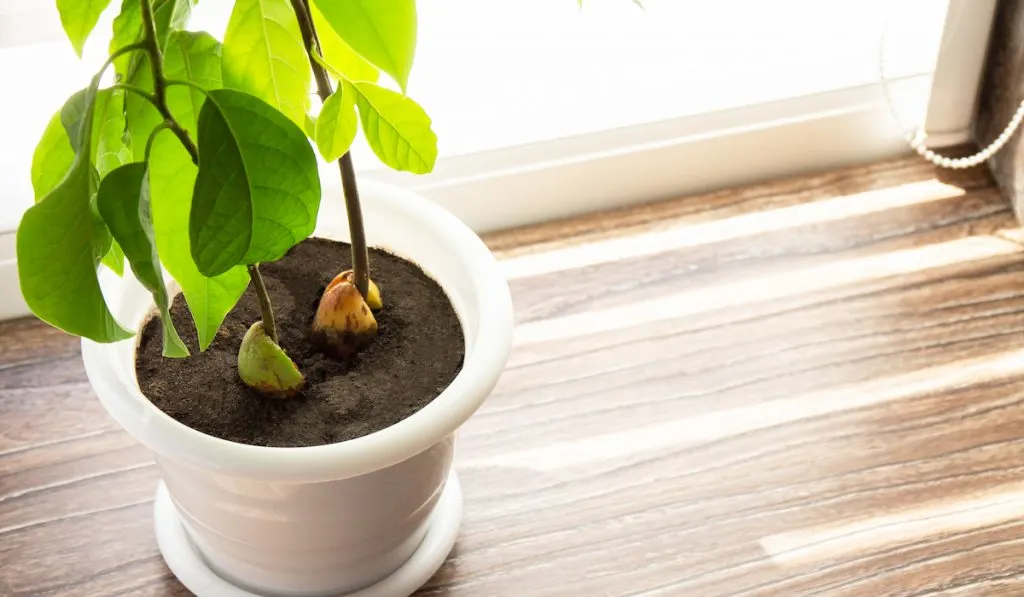
Can Avocado Trees Be Grown in Pots?
Avocado trees can be grown in pots. While avocados grown in the ground can reach heights of up to 80 feet, those grown in pots usually reach just 10 feet.
When growing avocado trees in pots, both the size of the pot you intend to use and the potting mix are vital. With these things in place, you are on your way to successfully growing an avocado tree in a pot.
Additionally, you have to expose the plant to just the right amount of sunlight. You also have to provide the right amount of water and keep the plant at the right temperature, amongst other things.
Planting Your Avocado Tree in a Pot
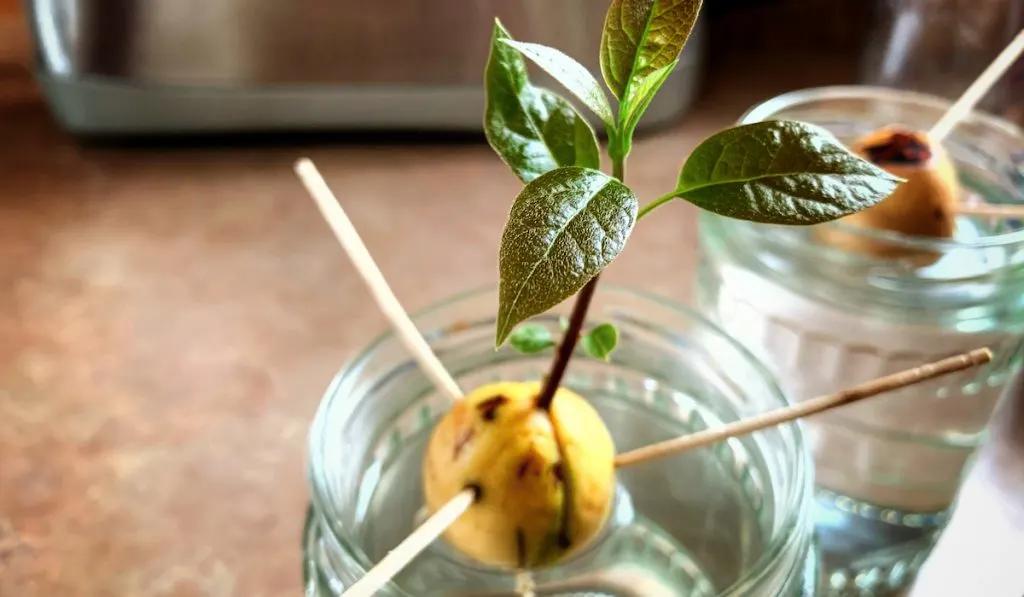
Propagation
You can germinate your avocado tree from a seed (pit) or propagate it from a graft. While planting the pit is easy, you should opt for grafting if you can.
Remember, if you are looking to plant dwarf avocado trees, you should get a seed or graft of dwarf avocado trees only.
Avocado trees grown from seeds typically take a longer time to produce fruit than grafted nursery stock. With the seeds, it could take 5 to 13 years before you notice any fruit. But the grafted plants would produce fruit in as few as 3 to 4 years.
Potting
Once you have the propagation material (seed or graft), the next thing is to get the pot and the potting mix.
The potting mix for planting avocado trees should be well-draining. It should also be rich in organic matter and manure. The mix could be blended with some compost and sand to improve the draining ability.
Avocado trees are best grown in soil with a pH between 6.2 and 6.5. But they will thrive in both acidic and alkaline soils.
Once you have the potting mix to specification, get the pot or container. If you buy a grafted tree, you should get a pot at least 1 to 2 sizes up to twice the size of the pot it is sold in. Generally, for dwarf avocado trees, a 15-gallon pot is sufficient when they become mature.
You could opt for a wooden, ceramic, or plastic pot.
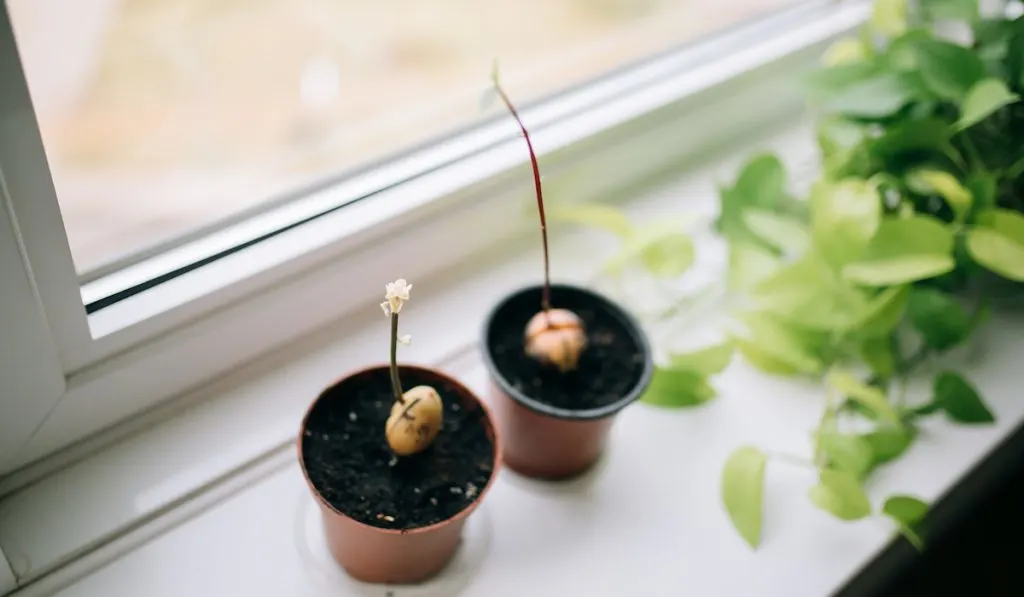
Of the three options, plastic pots are the cheapest. They are also the easiest to move around, but they may not be the most attractive.
Wooden pots are also inexpensive. They are durable, so you can keep them outside all through the year. They hold water pretty well, and they last quite long.
Ceramic pots, on the other hand, are the most expensive types of pots. They are the best draining of the three options. However, they break easily.
While choosing a pot, ensure your choice has sufficient drainage holes at the bottom. This will keep the soil from getting soggy.
Planting
When you are ready to plant the avocado tree, fill about three-quarters of the pot with the potting mix.
If you are propagating with the pit, suspend it in tepid water for a few hours.
To suspend the seed, push three toothpicks into it across the center, then place in a glass of water. After this, bury it in the soil in the pot.
If you are starting with a grafted nursery plant, be gentle while transplanting. If you do not uproot the tree gently, you may ruin the roots.
To get the plant out gently, pull from the part of the stem closest to the soil. Once the plant is out, place it in the new pot and cover it with more potting mix.
Once you are done planting the avocado tree, you should water the soil immediately. You may also fertilize it at this time.
While watering the soil, ensure you do not add too much water.
How to Care for a Dwarf Avocado Tree
By following the care tips below, you should be able to ensure your dwarf avocado tree reaches maturity successfully:
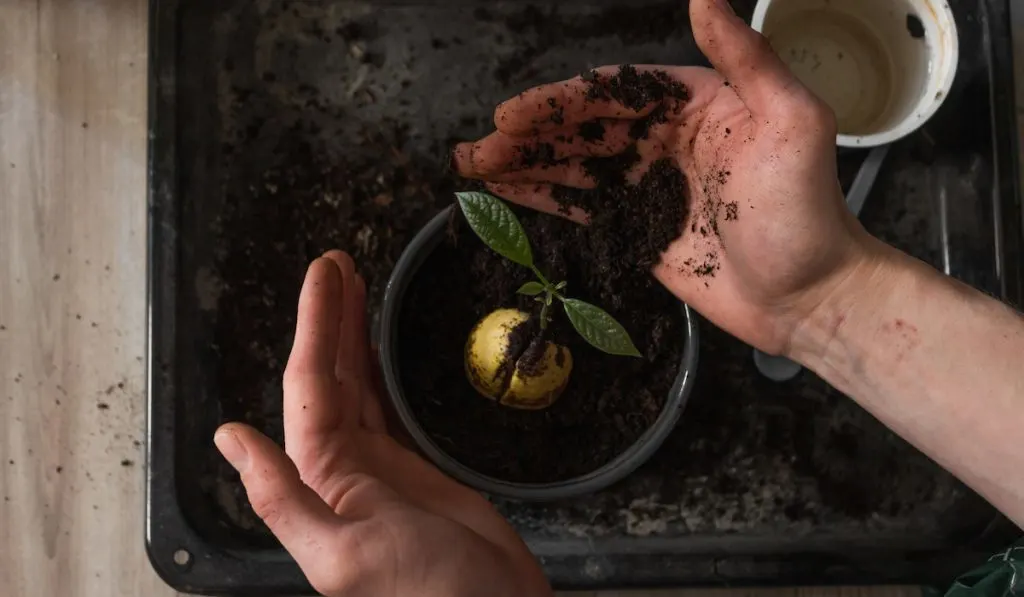
Watering
Like every other plant, avocado trees need water – a lot of it. While this is true, you should strive to water infrequently but sufficiently. All in all, the conditions around the plant will determine how often you have to water it.
When it is summer or spring, you may have to water your avocado plant more frequently. These periods have higher temperatures, so evaporation is faster. Faster evaporation means water leaves the soil faster.
In fall and winter, you may not have to water the plant as much. Evaporation is slower, so water won’t leave the soil very fast.
You may choose to water your plant every 2-3 weeks. Check to ensure that the soil is dry to touch before you water again.
The most vital consideration is to avoid overwatering the plant. Overwatering puts the plant at risk of root rot.
It is advisable to water your avocado plant in the morning or late in the evening. There is relatively minimal evaporation at these times. That way, the water remains in the soil for a longer period.
Temperature
Most varieties of avocado cannot thrive below 50°F. But the dwarf avocado variety can tolerate temperatures as low as 28 to 32° F.
Avocado trees thrive best in warm temperatures. The range of 60 to 85°F is optimal for the growth of avocados.
While dwarf avocado trees can survive temperatures around 28 to 32 °F, you should not leave them in such conditions for long. Leaving your tree in conditions as cold as that leaves them at risk of cold drafts, which can be damaging.
If you leave your avocado outdoors during the warmer months, you should move it indoors during winter if your area experiences temperatures approaching freezing.
Humidity
Avocado trees are best grown in medium to high humidity. They do well in relative humidity between 45% and 65%. However, they have been shown to grow well in areas averaging humidity of 30-50%.
In hotter conditions, relative humidity is lower. This will cause the air to be very dry. Consequently, the function of the stomata of the avocado leaves will reduce.
Aim to maintain the humidity around your avocado tree within the moderate to high range. If the humidity falls too much, you can work around it by misting the leaves at intervals. Alternatively, you may use a humidifier.
Light
Avocado trees need a significant amount of sunlight. They thrive when exposed to partial or full sunlight. On average, dwarf avocado trees need around 6 hours of direct sunlight daily.
In the early years of your avocado tree’s life, do not let it get too much sunlight. Say in the first 3 years, limit the amount of light you expose them to. Else, their bark, leaves, and stems could get burnt. It could also stunt their growth.
But after 3 years, you could let them get around 6 to 10 hours of sunlight daily.
If you intend to keep your avocado tree indoors, you should place it around a large south-facing window. Alternatively, you may place it around a balcony that receives sufficient sunlight. Without sufficient sunlight, avocado trees kept indoors will not produce fruit. It may also become untidy.
Repotting
After a while, your avocado tree might overgrow the pot you planted it in. This is especially true when you do not change the pot the nursery plant came in. When this happens, you have to repot the tree.
In a situation where you will have to repot, you can expect to do so after 4 to 6 months. Look for a new pot twice the size of the current one.
The optimal season to repot an avocado tree is in spring. The soil is not too dry, and the weather is not too cold. Before you repot the tree, water it for about 30 seconds, then follow the same process we described in the planting section of this article.
After the first repotting, you may only have to repot every 2 years. But there is no saying that you cannot do it every year.
Once you are done repotting, do not forget to fertilize the soil again.
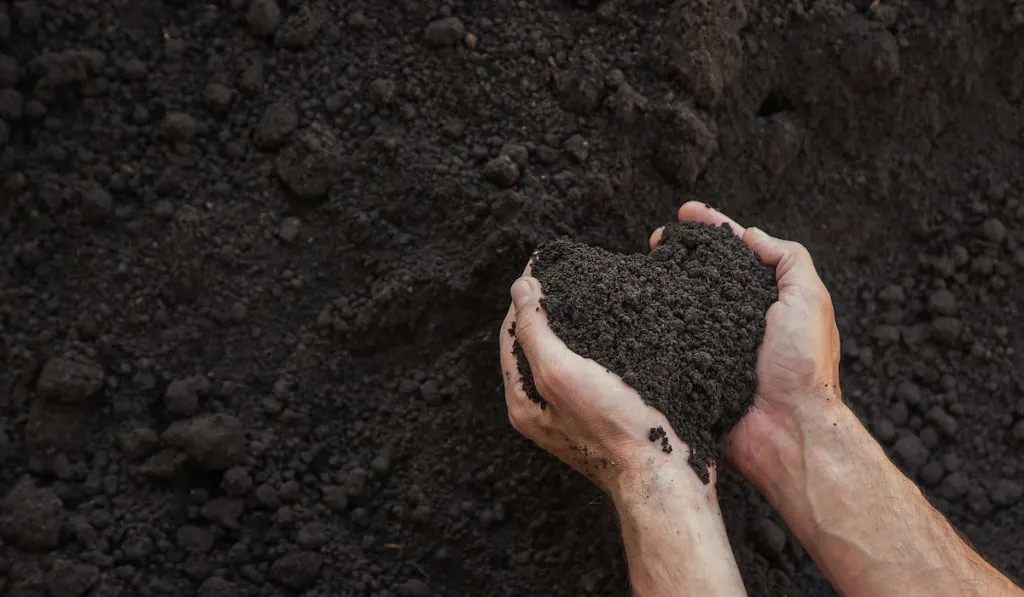
Fertilizing
Avocado trees may thrive without fertilizer. But you will get the best results if you fertilize your tree.
Some sources recommend fertilizing your avocado tree after the first year. You may choose to use a 3:1:2 slow-release fertilizer, a well-balanced citrus fertilizer, or a 10-10-10 fertilizer. You can also fertilize the tree with fish emulsion, compost, or coffee.
You may choose to fertilize your tree once a year or 2-4 times a year. The recommendation of the fertilizer manufacturer should guide your choice.
You should not fertilize your avocado tree at just any time. It is best if you do this before the flowers or fruits appear. Once the flowers bloom, applying fertilizer may damage the tree and keep it from bearing fruits.
Going by the above, spring appears to be the best time to fertilize your avocado tree.
Pests and Diseases
A vital part of caring for your dwarf avocado tree is checking for pests and diseases.
One disease avocado trees are at risk of is root rot. Symptoms of this disease include yellow leaves and dropping leaves. Root rot is caused by overwatering or poor drainage. So, if you use a well-drained potting mix and you do not overwater, your tree should be fine.
Your avocado tree may show symptoms of tip burn on the leaves and white crusts in the soil. When you spot these symptoms, you should suspect excess salt accumulation. To manage this condition, clean out the soil.
Pour some water into the soil and let it flow through the drainage holes for some minutes.
Avocado trees can be attacked by pests such as spider mites and scales. One sign of spider mite infestation is the brown or purplish discoloration of the leaves.
You can get the spider mites out of your tree by spraying it with neem oil. The same solution would also work on scales.
How to Prune Dwarf Avocado Trees
You might be able to get by without pruning your tree. But you most likely will not enjoy doing that. To prune your dwarf avocado tree, follow the steps below:
- When you are about the plant the tree, trim the top of the tree. This is particularly necessary if the roots were trimmed at the nursery. By trimming the top, you ensure that the roots are not overwhelmed by the tree’s canopy.
When trimming the top, cut to just above a lateral-growing branch or a bud. Trim with a pruning saw or loppers.
- Quarterly, pinch the ends of branches if what you have is a columnar-growing cultivar. Doing this promotes branching.
- Cut out the terminal buds atop the leading branch. Do this with a pruning saw. This will prevent the top from sprouting out too quickly.
- All through the year, whenever you come across dead branches, prune them out. When you trim them out, cut them to just around the branch collar.
- You may also do some light thinning on the branches at any time. Doing this improves sunlight penetration on otherwise dense canopies.
- If you notice suckers around the base of the tree, cut them out. Suckers will steal water and nutrients from your tree.
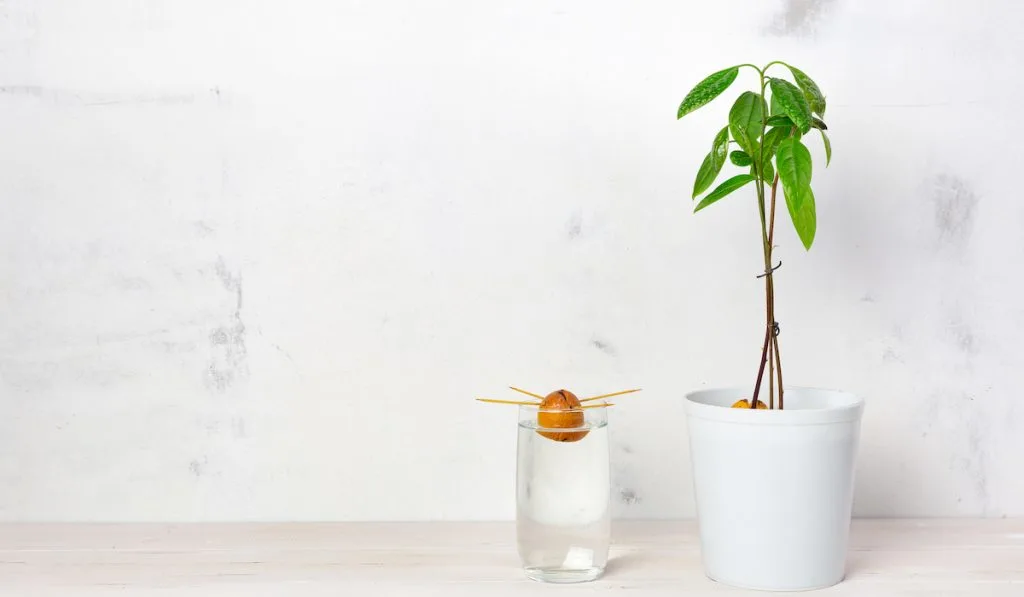
Harvesting
Avocado trees grown in pots do not produce as many fruits as those grown outdoors. In some cases, they do not produce any fruit at all.
As we already mentioned, if you cultivate your tree with a seed, it will take an awfully long time before it produces fruit. But with a graft, you should get fruit in a shorter period.
Avocados ripen off the tree. So, if you do not pluck it, it may get bigger but not ripen. One sign you might see when avocados are ready to be harvested is the appearance of small brown specks.
When you see these specks, you may leave the fruit on the tree for some time. Doing this allows the avocados to produce more oil and get bigger. This, in turn, gives the avocados more flavor.
When you finally harvest your avocados, do not eat them immediately. Plucked avocados are unripe. But once you harvest them, they should become ripe at room temperature in about a week.
Things to Avoid
So far, we have discussed many things you should do to ensure your dwarf avocado tree grows in a pot. Below are some things you should avoid:
- Do not let the trees stay in the dark for too long. You may even get a grow light if the exposure to darkness is prolonged.
- Do not let your tree stay around other plants suffering from pests or disease. The proximity to such plants leaves them at risk of the same disease.
- Do not fill your pot with garden soil. This type of soil is not well-draining, so your tree might get root rot.
- Do not let branches droop below the base of your tree. There is a good chance they will snap when there is sufficient wind.
- Do not fertilize your plant excessively. Follow the manufacturer’s recommendation and monitor your tree’s response to fertilization.
- Do not let the tree grow too heavy. There will be times you need to move it around. But if it is heavy, you can imagine how hard moving it will be.
Resources
- https://www.gardeningknowhow.com/edible/fruits/avocado/avocado-tree-with-no-fruit.htm
- https://thegardeningdad.com/10-easy-tips-to-grow-avocado-in-pots/
- https://balconygardenweb.com/growing-avocado-indoors-planting-tree-in-container/
- https://www.gardeningknowhow.com/edible/fruits/avocado/indoor-avocado-plant-care.htm
- https://homeguides.sfgate.com/grow-hass-avocado-tree-container-46191.html
- https://californiaavocado.com/how-to/how-to-grow-your-own-avocado-tree
- http://www.extento.hawaii.edu/kbase/crop/crops/i_avocad.htm
- https://www.avoseedo.com/what-not-to-do-when-growing-an-avocado-in-a-pot
- https://www.fast-growing-trees.com/pages/avocados-tips-growth
- https://homesteadandchill.com/how-to-grow-avocados
- https://www.gardeningknowhow.com/edible/fruits/avocado/how-to-fertilize-avocados.htm
- https://www.gardendesign.com/how-to/spider-mites.html
- https://homeguides.sfgate.com/prune-small-avocado-tree-54581.html
